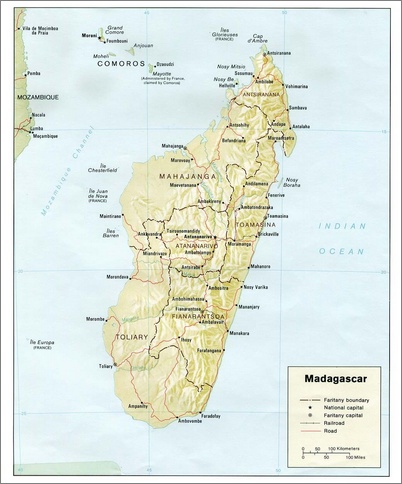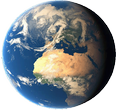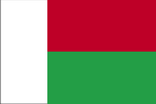





| The capital of Madagascar is by far the largest city of the Island. It has a bad reputation as the crime rates are relatively high. As a tourist it's wise not to walk around with flashy cameras or much money in your pocket. Having said that, the center with its castle on a hill with beautiful views is safe and worth a visit. We only spent a night there and haven't seen much of the city itself. |

| Antsirabe is the 'capital' of the pouse-pouse (Madagascar Riskja). The main way of being transported in town is by man-driven pouse-pouse. They are everywhere. Of course we made our little tour through town as well by pouse-pouse. Although we enjoyed you also feel sorry for the guy that pulls you on bare feet... |
| The most easily accesible National Park of Madagascar is this twin-park 3 hours east of Tana. the Andasibe-section is the best place to see the biggest of all lemurs: the indri. Its calls are probably one of the most memorable sounds you'll encounter in any rainforest. Visiting this park with one of the parkguides gives you an almost guaranteed closeup view with this strange looking lemur. Apart from the Indri a dozen other lemurs inhabit the park. One of the most attractive of those is the Diademed Sifaka. Your best chances of seeing this lemur is to visit theMantadia section, which is less visited that the adjacent Andasibe park as it is more remote. There you will encounter less tourists and have better chances of spotting shyer lemurs and birds. We had the luck (thanks to our tourguide, Eugene) to be guided by one of the discoverers of the Mantadia section. He had an enourmous knowledge of the flora and fauna. We saw many birds and lemurs we definately wouldn't have seen without his guidance. A nightwalk is also highly recommended as you will have good chances of spotting mouse lemurs, tree frogs, chameleons and other nocturnal critters. |

| If lemurs is the thing you're after, than Ranomafana is the National Park to visit. It harbours 13 species of lemur of which all three species of Bambooolemur are the highlight. On a single afternoon we spotted 7 species of Lemur, thanks to the very dedicated guides that are absolutely brilliant in locating these often elusive animals. The combination of the fact that it is very mountainous terrain, that it rains nearly every day and that finding emurs involves a lot of bushwalking, makes it a very demanding way of wildlife viewing. But the rewards are great. Birdife is also prolific, although we were there in the 'dry' season in which most birds keep quiet. Also a nightwalk along the main road that traverses the park is worth doing, as it will yield sightings of frogs, chameleons and if you're lucky dwarf and mouse lemurs. |

| This pittoresque little townis most well known for its papermaking. We visited a workshop where you could observe the whole process from harvesting of the plant leaves to the end product: decorated papier sheets. The town itself has a nice little market that allows you to observe daily life. Close to town is a privately owned nature reserve called Anja, that is probably th e best place in Madasagcar to see Ring-tailed Lemurs. Close encounters with these creatures are a guarantee. |

| We only briefly stopped here for a break. We made a little stroll through the upper town, which is the old french quarter. It has some nice old alleys and streets with pittoresque houses and churches. It is actually an Unesco world heritage site. So if you happen to stop in this town, you may just as well have a look. |

 |
 |
 |
 |
 |

| This part of Madagascar is not often visited by tourists and allows you to see some of traditional rural life of the Malagasies. During the French occupancy a series of canals was constructed that ran parallel to the seashore. This allowed people to efficiently and safely transport their merchandise from one place to the other without the need to negotiate over the rough and unpr edictabe sea. These canals are still being used for that same purpose. We made tour on these canals to visit some local villages, have lunch on the beach and see daily life of local fisherman and farmers. |
| Physical activities: eg Walking / Rafting / swimming Nature: eg National Park / Reserve City / Cultural site |
 |
 |
 |
 |
 |
 |
© Bart Everts
 |
 |

| We started our holiday in Madagascar on the west-coast near the town of Ifaty. Apart from relaxing on the beach, we went for a couple of dives at the coral reefs lining the coast and for some humpbackwhale watching. In addition, we visited the socalled spiny forest east of the village. This type of forest is typical of the dry south west and is both in terms of flora and Fauna unique. The forest is characterized by many giant spiny euphorbia trees, brachypodium trees and strangely shaped baobtrees. It is a hotspot for birders as the forests are home to very localized endemic species such asseveral vanga species, subdesert mesite and longtailed Groundroller. local kids are great help in locating these elusive birdspecies. |

| Probably one of the most diverse parks of Madagascar is Isalo. This rocky plateau is extremely photogenic as it rises several hundred meters above the rest of the land. The plateau is intersected by several deep canyons acrved by rivers, in which in contrerary to this arid region are filled with lush green forests and plants. These canyons are a magnet for birds, lemurs and are dotted with little pools and waterfalls. Combined with the fact that the hikingtrails in this park are also well maintained and marked, makes this park the most popular of all parks in Madagascar. The chances of seeing Verreaux Sifaka, have fabulous panoramic views and swim in one of the natural pools more than compensate for the many other tourists you will encounter. |

 |
 |
 |
 |










